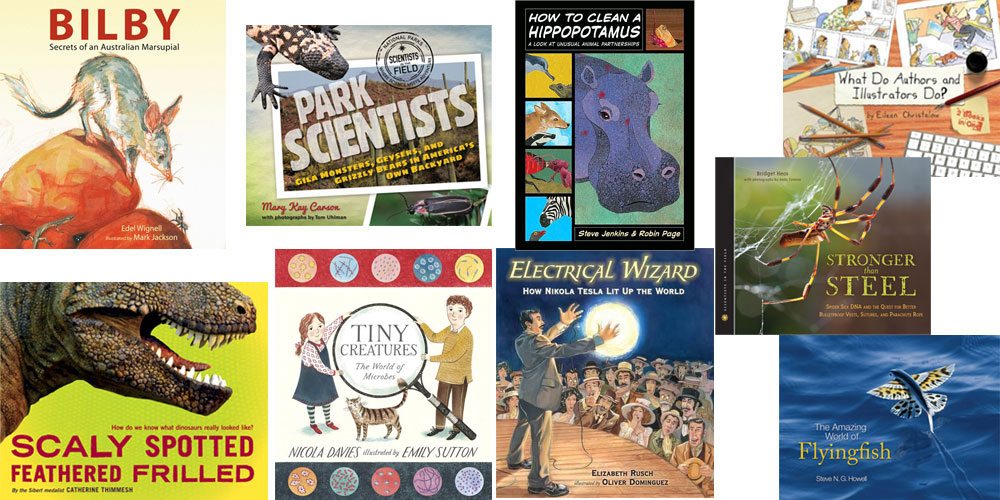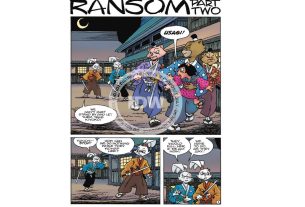Disclosure: GeekDad received review copies of the books in this column. Making purchases through the affiliate links on GeekDad helps support our writing. Thanks!
Last time I shared a bunch of books that were educational usually through stories. This time I have a stack of books that are (mostly) more non-fiction for kids, making them a good bet for readers who like lots of facts.
First, some picture books:
Bilby: Secrets of an Australian Marsupial (by Edel Wignell, illustrated by Mark Jackson) is about a small, mouse-like marsupial. I first learned about it from Michael Hearst’s Songs for Unusual Creatures. This book is a picture book that combines a story with facts–each page has a bit of story about one particular mom-and-child bilby family, followed by another fact or two about bilbies, set in a different font.
How to Clean a Hippopotamus (by Steve Jenkins and Robin Page) is all about animal partnerships: small animals that help clean larger predators, animals that hunt together, and so on. The book is illustrated with beautiful cut-paper art, and in the very back is an index listing each animal’s size, habitat, and diet.
Tiny Creatures: The World of Microbes (by Nicola Davies, illustrated by Emily Sutton) is a picture book that introduces kids to microbes. The text is strictly non-fiction, but it’s formatted like a standard picture book so it’s easy to understand and not too overwhelming. While there are some illustrations of microbes themselves, most of the book relies on analogies, or else shows the effects they have on us and the environment.
What Do Authors and Illustrators Do? (by Eileen Christelow) is a two-part book explaining how authors and illustrators work. Cartoon illustrations show two authors and two illustrators going about their business and the different approaches somebody might take to writing a book or illustrating a book. There’s a postscript that mentions digital illustration, but nothing really about the growth in self-publishing. Still, for kids who are curious about what goes into making a book, it’s a cool overview and even has tips in the back for writing and illustrating their own ideas.
For you Tesla fans, Electrical Wizard: How Nikola Tesla Lit Up the World (by Elizabeth Rusch, illustrated by Oliver Dominguez) is a picture-book retelling of a very small portion of Nikola Tesla’s genius. It’s specifically about his ideas about using alternating currents for electricity. The book does touch on his rivalry with Edison (and Edison’s smear campaign), but doesn’t dwell on it too much. There’s also a section in the back that digs a little deeper into how things work: comparing AC to DC, explaining how Tesla’s AC motor works, and so on.
Scaly Spotted Feathered Frilled (by Catherine Thimmesh) is all about what dinosaurs looked like. If all we have are fossils and bones, how do we know what they really looked like? Thimmesh explains how paleoartists (those who try to create scientifically accurate portrayals of dinosaurs) start with the science and build up from there. The book includes some photos and diagrams of skeletons, as well as plenty of dinosaur art. It’s fun seeing older artwork and getting an explanation of what the artists got wrong, and what we currently know about dinosaurs.
Now, for a couple of books with photography instead of illustrations:
The Amazing World of Flyingfish (by Steve N. G. Howell) is a small hardcover (about the size of an iPad Mini, perhaps) with lots of facts about flyingfish–among them, that “flyingfish” is one word according to biologists. Mostly, though, it’s filled with lots of gorgeous photos of the fish in flight. I had no idea there were so many different varieties of flyingfish, and I’d never seen so many photos of them in one place.
Stronger Than Steel (by Bridget Heos, photos by Andy Comins) is a hefty book–although it looks like a hardcover picture book, it has nearly 80 pages and has a lot more text than a typical picture book. It’s all about spider silk, golden orb weaver spiders, and transgenics (like the goat that produces spider silk proteins in its milk). Spider silk is fascinating stuff, and this book digs into it. Very cool, though maybe a bit lengthy for tiny readers.
Park Scientists (by Mary Kay Carson, photos by Tom Uhlman) is another book in the “Scientists in the Field” series like Stronger Than Steel. After a brief overview of national parks, the book explores Yellowstone, Saguaro National Park, and the Great Smoky Mountains. Again, lots of facts and photographs–this time, about geysers, grizzly bears, gila monsters, saguaro cacti, salamanders, and fireflies.













